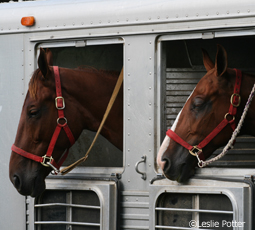 Crude oil prices continue to remain over $100 a barrel in 2011, with resulting gasoline
Crude oil prices continue to remain over $100 a barrel in 2011, with resulting gasoline
prices reaching $4 per gallon. It will be more important than ever to conserve energy and
save fuel costs. You can improve your fuel economy – as well as your safety and the safety
of your horses – by following these simple tips:
- Drive more efficiently.
- Keep your vehicle properly tuned.
- Plan and combine trips.
- Choose a more efficient vehicle.
tips that actually work.
The energy market is extremely volatile and could increase, putting additional strain
on budgets.
USRider urges horse owners to take a multi-faceted approach to conserve energy and to
lower their overall fuel costs while traveling with their horses. Here are some
suggestions for conserving fuel while traveling. These tips work for most vehicles:
Vehicle Maintenance
- Keep Engine Properly Tuned – Depending upon the kind of repair done, this can result
in an average 4 percent increase in fuel efficiency. Replacing a faulty oxygen sensor can
improve fuel mileage as much as 40 percent. - Check & Replace Air Filter – Replacing a clogged air filter can improve your vehicle’s
mileage up to 10 percent. - Keep Tires Properly Inflated – Proper inflation can increase your mileage by around 3
percent. An added benefit is that properly inflated tires are safer and last longer.*
Use Recommended Grade of Motor Oil – Using the incorrect weight can increase fuel
consumption by 1-2 percent. Look for motor oil that says “Energy Conserving” on the API
performance symbol to be sure it contains friction-reducing additives.
Vehicle Operation
- Drive Sensibly – Aggressive driving can lower your fuel mileage by one-third. Sensible
driving is also safer for your horse(s). - Observe the Speed Limit – The Department of Energy says that each 5 mph you drive over
60 mph is like paying an additional $0.21 for each gallon of fuel. An added benefit is
that observing the speed limit is also safer for your horse(s). - Avoid Excessive Idling – Idling gets 0 miles per gallon.
- Use Cruise Control – Using cruise control (where applicable) helps you maintain a
constant speed and, in most cases, will save fuel. Do not use cruise control if you are
tired or fatigued. In fact, if you are tired or fatigued, you shouldn’t be trailering
horses. - Use Overdrive Gears – When your engine speed goes down, your mileage goes up. An added
benefit is that using overdrive gears reduces engine wear.
Vehicle maintenance and safe operation also helps the environment. A properly tuned
vehicle with correct tire inflation, driven at the correct speed reduces the detrimental
impacts automobiles have on the environment.
“Another tip is to lower your fuel costs by shopping around,” said Bill Riss, general
manager for USRider. “Don’t wait until your tank is empty – shop for low prices.”
Numerous Internet resources are available to help in the hunt for cheaper fuel:
- www.gaspricewatch.com
This website uses volunteers to report prices at over 100,000 fuel prices all over the
country. Simply enter your ZIP code. - www.gasbuddy.com
The website also works with ZIP codes and compiles information from other websites that
track local prices.
Additional fuel economy tips are posted on www.fueleconomy.gov. This site also has
links to local fuel prices and information about Wacky Wednesdays and other
promotions.
Through its Equestrian Motor Plan, USRider offers nationwide roadside assistance
especially for equestrians. The plan includes standard features such as flat-tire repair,
battery assistance and lockout services, plus towing up to 100 miles and roadside repairs
for tow vehicles and trailers with horses, emergency stabling, veterinary and farrier
referrals, and more.
*Additional information about air pressure: Underinflation is the leading reason for
early tire failure – tires can lose up to 50 percent of their air and not look flat or
low. Air pressure goes up in warm weather, down in cold weather – approximately 1-2 pounds
for every 10 degrees of temperature change. Don’t forget to check spares on both your
trailer and tow vehicle. USRider recommends carrying two mounted spares for your horse
trailer. For trailer tires, the recommended air pressure is stamped on the side of each
tire. For vehicles, air pressure recommendations are stamped on the vehicle door edge,
doorpost, glove box or fuel door – and owner’s manual. Check the pressure when tires are
cool – before you drive.
For more information about USRider and more equine trailer safety tips, visit the
USRider website at www.usrider.org, or call (800) 844-1409.
Further Reading
Towing Capacities
Safe Trailering
Trailering Checklist
Club Equestrian introduces ride share program







My hubby said “drive less”, so no more going to clinic, shows, or sales….just to watch and see. I only get to go to one sale this year to pick up items I need, but will do more ordering from catalogs. When you live 50 some miles from any town, that still is a 100 mile drive.
Does it save on gas consumption: with the windows open or with the windows shut (on the trailer)? Do mud flaps really cut down on fuel efficiency?
thanks for the tips, we can all benefit from these with the fuel prices sky rocketing!
Good tips- but its hard when shows and things are so far away
Great tips! Thank you!
Great tips but still expensive!